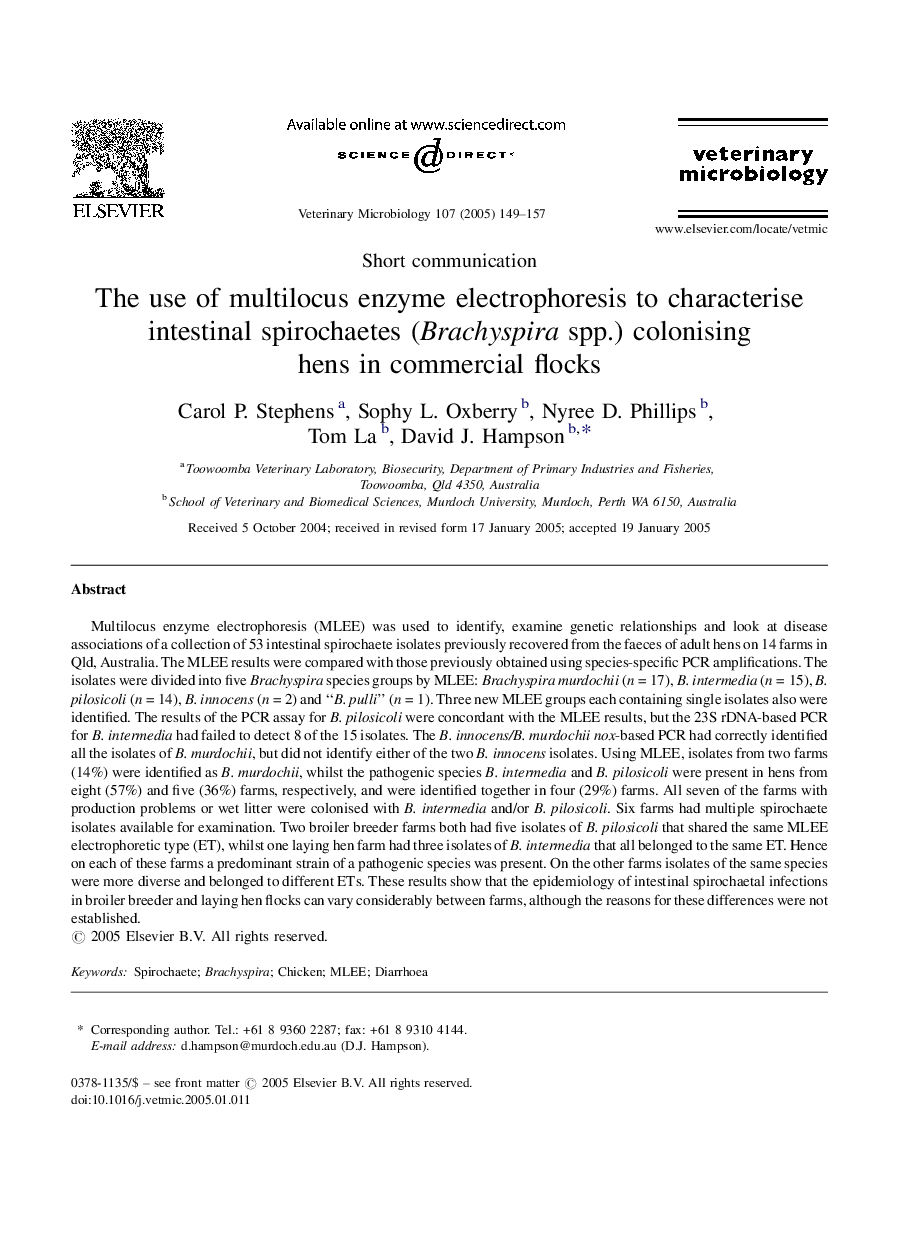| کد مقاله | کد نشریه | سال انتشار | مقاله انگلیسی | نسخه تمام متن |
|---|---|---|---|---|
| 8989504 | 1555477 | 2005 | 9 صفحه PDF | دانلود رایگان |
عنوان انگلیسی مقاله ISI
The use of multilocus enzyme electrophoresis to characterise intestinal spirochaetes (Brachyspira spp.) colonising hens in commercial flocks
دانلود مقاله + سفارش ترجمه
دانلود مقاله ISI انگلیسی
رایگان برای ایرانیان
موضوعات مرتبط
علوم زیستی و بیوفناوری
علوم کشاورزی و بیولوژیک
علوم دامی و جانورشناسی
پیش نمایش صفحه اول مقاله

چکیده انگلیسی
Multilocus enzyme electrophoresis (MLEE) was used to identify, examine genetic relationships and look at disease associations of a collection of 53 intestinal spirochaete isolates previously recovered from the faeces of adult hens on 14 farms in Qld, Australia. The MLEE results were compared with those previously obtained using species-specific PCR amplifications. The isolates were divided into five Brachyspira species groups by MLEE: Brachyspira murdochii (n = 17), B. intermedia (n = 15), B. pilosicoli (n = 14), B. innocens (n = 2) and “B. pulli” (n = 1). Three new MLEE groups each containing single isolates also were identified. The results of the PCR assay for B. pilosicoli were concordant with the MLEE results, but the 23S rDNA-based PCR for B. intermedia had failed to detect 8 of the 15 isolates. The B. innocens/B. murdochii nox-based PCR had correctly identified all the isolates of B. murdochii, but did not identify either of the two B. innocens isolates. Using MLEE, isolates from two farms (14%) were identified as B. murdochii, whilst the pathogenic species B. intermedia and B. pilosicoli were present in hens from eight (57%) and five (36%) farms, respectively, and were identified together in four (29%) farms. All seven of the farms with production problems or wet litter were colonised with B. intermedia and/or B. pilosicoli. Six farms had multiple spirochaete isolates available for examination. Two broiler breeder farms both had five isolates of B. pilosicoli that shared the same MLEE electrophoretic type (ET), whilst one laying hen farm had three isolates of B. intermedia that all belonged to the same ET. Hence on each of these farms a predominant strain of a pathogenic species was present. On the other farms isolates of the same species were more diverse and belonged to different ETs. These results show that the epidemiology of intestinal spirochaetal infections in broiler breeder and laying hen flocks can vary considerably between farms, although the reasons for these differences were not established.
ناشر
Database: Elsevier - ScienceDirect (ساینس دایرکت)
Journal: Veterinary Microbiology - Volume 107, Issues 1â2, 25 April 2005, Pages 149-157
Journal: Veterinary Microbiology - Volume 107, Issues 1â2, 25 April 2005, Pages 149-157
نویسندگان
Carol P. Stephens, Sophy L. Oxberry, Nyree D. Phillips, Tom La, David J. Hampson,